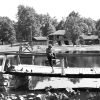calsfoundation@cals.org
Carl Richey "Cotton" Cordell (1928–2015)
Few figures were more recognized in the multi-billion dollar sportfishing industry than Arkansas native Carl Richey “Cotton” Cordell Jr., who built a fishing tackle empire based in Hot Springs (Garland County) that grew to be the largest in America.
Carl Cordell Jr. was born in Benton (Saline County) on December 9, 1928, the only child of Carl R. Cordell and Alice J. Barnes Cordell. His father worked for Alcoa but moved the family in November 1945 to Lake Catherine near Hot Springs, where he had purchased a marina and resort. Cordell, nicknamed “Cotton” because of his light hair, spent most of his youth traversing the Arkansas outdoors for fish and game, becoming able to help his father at the marina in a number of capacities. He became particularly adept as a fishing guide, and he soon developed a national reputation. During these formative years, he also spent time as a commercial fisherman and minnow trapper.
It was not long before Cordell entered the fishing tackle manufacturing business. The first fishing lure he made was a lead-head jig that had been poured in a handmade plaster mold and dressed with materials he found handy. (Legend has it that he often used the fur of his pet English setter). In these early days, his lures were made in the kitchen and finished in the living room.
Cordell married Erma Lee Rothenberger on September 16, 1949; they had a son and a daughter.
In 1952, he established Cotton Cordell, Inc. The company was an immediate success, manufacturing lures for major fishing tackle companies such as Pflueger, Creek Chub, and Heddon. By 1954, Cordell was branding his own lures, many of which would become internationally famous. Cordell invented some of the spinners, spoons, and plugs himself and bought others, including the famous Gay Blade and Red Fin lures designed by J. C. Boucher of Tyler, Texas.
In 1973, Cordell produced the famous “Big O” lure designed by Fred Young of Tennessee, a popular hand-carved plug cherished by the leading tournament bass fishermen. It sold more than a million units in the first year alone. Eventually, Cordell expanded into many other areas of the fishing and boating world, ranging from fiberglass boats to plastic worms and fishing reel handles.
Through his sponsorship of tournament fishing, Cordell helped launch a number of careers. Among the anglers who benefitted from his patronage were television personality Bill Dance, whose first TV show Cordell produced, and Gary Loomis, who received start-up capital and rod-making equipment from Cordell when he launched his famous rod-making company in the early 1980s.
When Cordell Tackle Company, Inc., as it eventually became known, was sold to the Alabama-based EBSCO Corporation in 1980, it was the largest lure manufacturer in the world, making 22,000 lures per day. It employed 200 people in Hot Springs and an additional 350 overseas, sold fishing tackle through virtually every major retailer, and distributed tackle all around the world.
In the wake of the sale of Cordell Tackle to EBSCO, Cordell started a new firm specializing in graphite fishing rods known as Cotton Cordell Manufacturing, Inc. Cordell’s continued work in the fishing tackle industry eventually resulted in litigation with EBSCO over the use of name “Cotton Cordell”; it was settled in arbitration.
Cordell was inducted into the National Freshwater Fishing Hall of Fame in 1988 and the Arkansas Outdoor Hall of Fame in 1997. He was inducted into the Bass Fishing Hall of Fame in 2002. He died on January 6, 2015.
For additional information:
Ampezzan, Bobby. “Carl Richey ‘Cotton’ Cordell.” Arkansas Democrat-Gazette, October 30, 2011, pp. 1D. 5D.
Becker, A. C. “Cordell Lures Set Example for Success.” Galveston Daily News, July 2, 1976, p. 15A.
“Cotton Cordell.” Bass Fishing Hall of Fame. http://www.bassfishinghof.com/alphabetical-listing-of-inductees/cotton-cordell/ (accessed February 7, 2022).
Hendricks, Bryan. “Remembering Cotton Cordell.” Arkansas Democrat-Gazette, January 11, 2015, p. 10C.
McCarty, Guy. “The Hottest Bait Changes Hands: The ‘Big O.’” Abilene Reporter-News, April 8, 1973, p. 7C.
———. “Really Big Show.” Abilene Reporter-News, November 19, 1972, p. 8C.
Price, Steve. The Fish That Changed America: True Stories about the People Who Made Largemouth Bass Fishing an All-American Sport. New York: Skyhorse Publishing, 2014.
Scott, Ken. “A Lifetime of Lures.” National Fishing Lure Collector’s Club Gazette (July 1992): 5–8.
Todd E. A. Larson
Xavier University (Cincinnati, Ohio)






More years ago than I care to admit, I caught my best stringer of bass ever using Cordell’s Chrome Hot Spot. Fishing the Sam Rayburn reservoir in Southeast Texas, I caught 10 bass (when 10 was legal) that weighed 53 lbs., the largest being 7.2 lbs. Don’t know if they’re still making that bait, but it was a good one.
I am proud to have known Cotton and call him my friend. Without Cotton, Forrest Wood (boats), and Ray Scott (bass tournaments), bass fishing would not be what it is today.
R.I.P. COTTON, You were truly a pioneer and loved and admired by many.
Cotton Cordell bought the designs for the Gay Blade, Hot Spot, and Redfin baits from my father, J. C.Boucher Jr. I fished with many of these before they were even sold to Mr. Cordell.